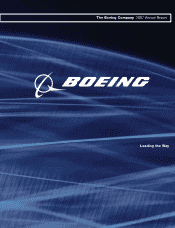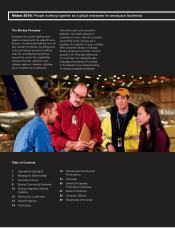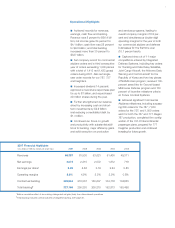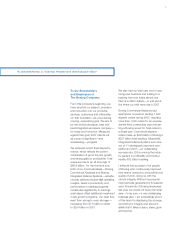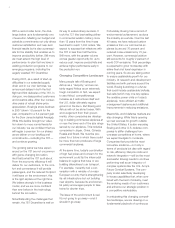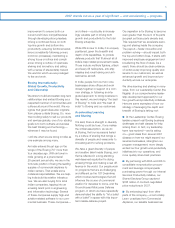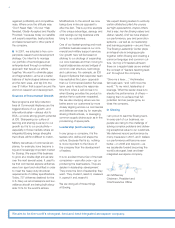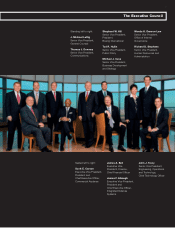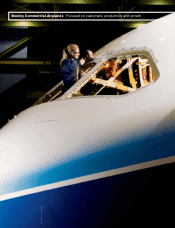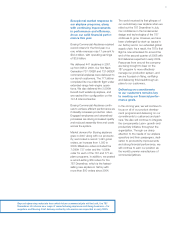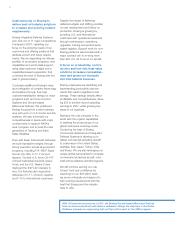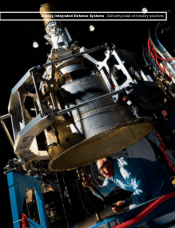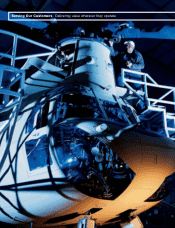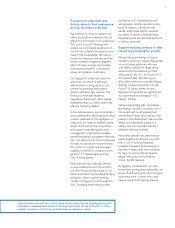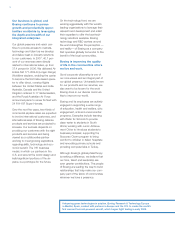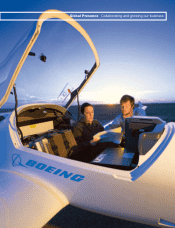Boeing 2007 Annual Report Download - page 9
Download and view the complete annual report
Please find page 9 of the 2007 Boeing annual report below. You can navigate through the pages in the report by either clicking on the pages listed below, or by using the keyword search tool below to find specific information within the annual report.
6
regained profitability and competitive-
ness. Where once the attitude was
“Don’t Need Help,” it’s now “Help
Needed, Gladly Accepted and Readily
Provided,” because today our satellite
unit exports expertise, best practices
and lessons learned to other parts of
the company.
■ In 2007, we adopted a true com-
panywide research-and-development
strategy. Our intent is to manage
our portfolio of technologies at an
enterprise level through a matrixed
approach that ties all our efforts
together. We want to eliminate gaps
and fragmentation, arrive at a better
balance of technologies between near-
and far-term uses, and tap into the
over $1 trillion that is spent around the
world on research and development.
Sources of Incremental Growth
New programs and full production
lines at Commercial Airplanes are the
biggest drivers of our growth, and
international sales —always vital to
BCA— provide strong growth potential
at IDS. Sharpening our culture of
learning and sharing is as key to our
growth as it is to our productivity—
especially in those markets where an
integrated Boeing brings strengths
that others will find difficult to match.
Military derivatives of commercial air-
planes, for example, have become a
big and increasingly important market
for Boeing. We expect this business
to grow at a double-digit annual rate
over the next several years. It used to
be that commercial airplane airframes
were torn apart and retrofitted in order
to meet the heavy-duty structural
requirements of military specifications.
Today, 737 airframes destined for the
U.S. Navy as reconnaissance and sur-
veillance aircraft are being built along-
side 737s for the world’s airlines.
Modifications to the aircraft are now
being done in-line as opposed to
after-the-fact. This is a prime example
of the unique advantage, synergy and
cost savings our big business units
bring to our customers.
One of our fastest-growing and most
profitable business areas is our com-
mercial and military support services.
Our growth here will be based on
sticking to our strategy of expanding
our core business and then moving to
logical adjacencies across bridges of
common cost structure, technology
and customers. For example, an IDS
Support Systems first-responder team
has replicated the Lean+ approach
that our Commercial Aviation Services
team uses to reduce the response
time from when a call comes in to
when Boeing provides the product or
service that a customer requested.
We are also studying where we can
better serve our customers by more
closely aligning across our commercial
and defense services by, for example,
sharing infrastructures, or leveraging
common supply chains such as in the
provisioning of spare parts.
Leadership (and Leverage)
In any group or company, it is the
leaders who define and shape the
culture. Because that is so, nothing
is more important to the future of
the company than the development
of leaders.
It is no accident that a few of the best
companies— year after year —go on
producing the best leaders. They are
leaders
in leadership
development
.
They know the kind of leadership they
want. They
model
it,
teach
it,
measure
it,
expect
it and
reward
it.
We are doing all of those things
at Boeing.
We expect Boeing leaders to embody
certain attributes (
chart the course
,
set high expectations
,
inspire others
,
find a way
,
live the Boeing values
and
deliver results
). And we have shaped
our performance, pay and promotion
systems— as well as our leadership
and learning programs— around them.
The Boeing Leadership Center plays
an integral role in bringing people
together within Boeing and creating a
common language and common cul-
ture. Our top 270 leaders all teach
there on a regular basis as we embed
the concept of “leaders teaching lead-
ers” throughout the company.
“Give me a lever…,” Archimedes
famously said, “and I will move the
world.” To my mind, leadership
is
leverage. What the leader does is to
elevate the performance of others—
helping them to achieve their full
potential. And as people grow, so
does the company.
In Closing
I am proud to lead the Boeing team.
In every part of our business, our
people are rising to the challenge of
solving complex problems and deliver-
ing exceptional value to our customers.
We delivered record performance by
many measures in 2007, and I believe
our performance will become even
better— in 2008 and beyond —as
we accelerate toward becoming the
world’s strongest, best and best-
integrated aerospace company.
Jim McNerney
Chairman, President and
Chief Executive Officer
We aim to be the world’s strongest, best and best-integrated aerospace company.


